Excerpts from Jim Conrad's
Naturalist Newsletter
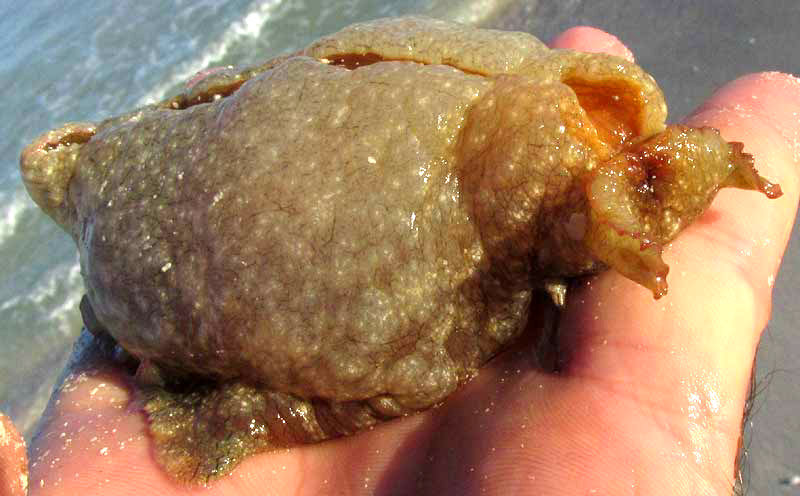
from the December 7, 2014 Newsletter issued from Río Lagartos, on the Yucatan Peninsula's northern coast (~N21.60°, ~W88.16°), Yucatán state, MÉXICO
SEA HARES
For several days a stiff norte had blown from the north, so I was glad to visit the sandy beach on the sea side of the long, slender finger of land separating Río Lagartos and its estuary from the Gulf of Mexico. I was glad because after such northerly winds the beach always is heaped with interesting things blown ashore. For me the most interesting find was the four-inch-long (10cm) item shown above.
You wonder about that groove running down the back. A better view of it is provided below:
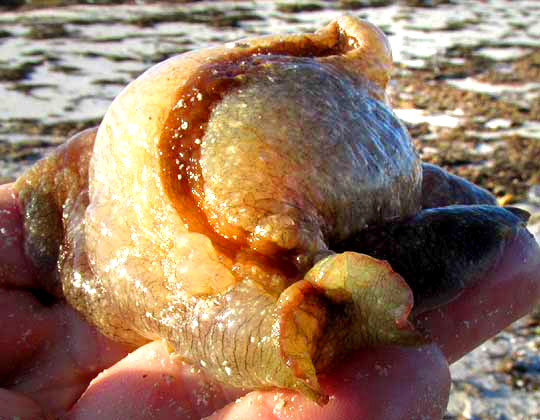
A look at the creature's bottom, with its "foot" spread out, is seen below:
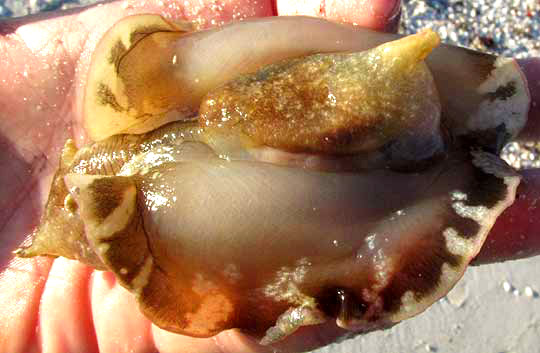
Dozens littered the beach that day, often still alive but dying from exposure. I was with a friend, biologist Wili Cruz, who said they always turn up like this at this time of year after nortes blow heaps of seaweed ashore. The creatures inhabit the seaweed so when waves uproot vegetation and blow it ashore, animals inhabiting the stems and leaves come with them. Wili called them by their local name, Agua Mala, agua mala meaning "Bad Water." The name refers to the purplish ink the animal expels into the water when disturbed, like a squid. Below, you can see some ink that got onto Wili's fingers as he was examining one:
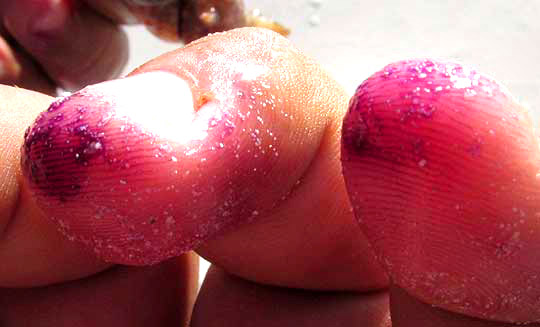
You might guess that this is some kind of large, slug-like animal, thus a gastropod, which is a kind of mollusk -- Class Gastropoda, which is a subdivision of the Phylum Mollusca. Our gastropod is traumatized by being washed ashore and exposed to sunlight and wind, so he's not fully deploying his tentacles and all the features of his head, which made identification harder. Still, doing image searches on the Internet on names of marine gastropods found in the Yucatan's waters, our discovery was found to be APLYSIA FASCIATA, commonly known as a Sea Hare or Sea Slug. *UPDATE: Later with much more info on the Internet, it appears that experts at the SeaSlugForum.Net website generally agree that Aplysia fasciata and Aplysia brasiliana are the same species, just that populations in the Old World are more likely to be named Aplysia fasciata, while here in the Gulf, usually Apysia brasiliana is used. Therefore, now I'm calling this APLYSIA BRASILIANA.
Having the name, details about Sea Hare life could be looked up. It was learned that Sea Hares, like many mollusks, have protective, snail-like shells, but they're inside the body, just beneath the fleshy covering of the broad hump on top. What seems to be a groove down the top is actually just an open space formed with the animal's two broad, winglike flaps are folded over the back. When the flaps are open there's no groove, and the flaps, called "parapodia," are undulated in a way that gracefully propels the Sea Hare through the water like a Manta Ray.
Sea Hares feed on aquatic plants and algae in shallow water. They're hermaphroditic, meaning that individuals possess both male and female sexual parts, so when they mate each individual both gives and receives sperm. I read that sometimes mating sea hares form chains, one releasing sperm to the animal ahead of it, while receiving sperm from the Sea Hare behind it. Eggs are laid in gelatinous chains that can be several yards (meters) long and contain over 20 millions eggs. Normally Sea Hares occur in waters less than 65 feet (20m) but sometimes they go deeper.
That day we found Sea Hares of various sizes and stages of development, including large numbers of much smaller ones with parapodia and other features hardly developed at all, as seen below:
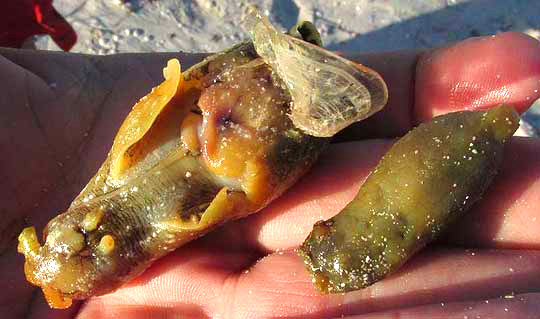
It's interesting that during my summer months along the Caribbean coast a few years back I never saw a Sea Hare. Probably that's because there the ocean just offshore was deeper, and it was a different time of year.
At first I threw all the stranded Sea Hares we found back into the water, but soon it became clear that there were just too many, surely hundreds of thousands all along the northern coast. It was one of those times when at some point you just have to look away, feeling bad about it.
Some consider our Caribbean Sea Hares to be separate from the Old World species, and give them the name Aplysia brasiliana. Throughout the species there's wide variation in color, many being black, and others being mottled. The broader species occurs generally in the North Atlantic and Mediterranean, and from the Caribbean to west Africa, south to northern South America.